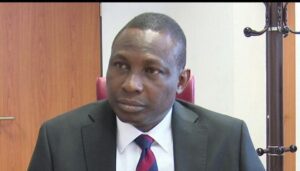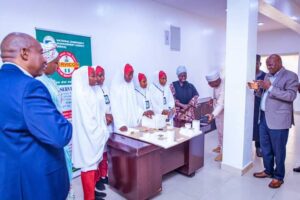
Leaders talk leadership
Editors: Meredith Ashby and Stephen Miles
Publisher: Oxford University Press, Inc
Reviewer: GokeIlesanmi
This text “Leaders Talk Leadership”with the subtitle”Top Executives Speak Their Minds” is edited by Meredith Ashby and Stephen Miles, business analysts at Heidrick& Struggles International, Inc, the world’s premier executive search and leadership services consulting firm.
Ashby and Miles work with the firm’s vice chairman of board services to deliver cutting-edge thought leadership on topics such as governance and human capital to clients worldwide.
Additionally, Ashby is a business development specialist in the firm’s office of the chairmen and Miles is involved in the firm’s leadership services practice.
These editors ask the questions of what gives companies the competitive advantage? How do CEOs lead in times of crisis or instability? Why do some companies identify, attract, develop and retain their best and brightest talent?Ashby and Miles illuminate that these are some of the questions that they wanted to answer as they conducted interviews with hundreds of CEOs, senior managers, financiers, academics and leadership and management experts.
These editors submit that production of this text was as a result of their unprecedented efforts, adding that this text contains strategies of men and women who have proven credentials as leaders time and again. Some of these leaders are Ken Chenault of American Express; Steve Reinemund of PepsiCo; Ken Lewis of Bank of America; Michael Dell of Dell Computer, etc.
Ashby and Miles stress that all these corporate leaders make clear, some of the world’s most respected, value-driven companies deriving an ever-increasing part of their valuations from the collective power of their intangible assets: brands, partners, intellectual property and people.
These editors say an overarching theme that emerges again and again is that the greatest single asset of any organisation is its human capital, the people with a vested interest in the business, to whom the business must in turn show a similar commitment in order to remain competitive.
They educate that from innovative and aggressive recruiting to progressive executive development programmes to creating developmental opportunities for promoting executives and to the challenging task of retaining highly-talented, motivated and productive teams, chief executives today face the daunting task of creating an environment in which people want to, and can, perform at the highest levels of their potential.
Ashby and Miles illuminate that those CEOs that have not questioned whether their companies are attracting, developing and retaining good people simply are not doing their company and the stakeholders justice. They assert that creative and influential leadership is the foundation of all great companies. They say this text taps into the collective wisdom of an unparalleled group of highly accomplished leaders and distills this wisdom into succinct essays.
As far as structure is concerned, this text is segmented into five chapters. Chapter one is entitled Leadershipand contributed by John Thompson, vice chairman of Heidrick& Struggles International. According to Thompson here, “Part of the soft skill set for leaders today is agility. Decisions need to (be) made quickly, and teams have to be pulled together quickly. This requires extreme agility, and not many people are blessed with it. In fact, the reason that many CEOs and division presidents fail is that they cannot respond quickly enough to changing market conditions. In addition to decisiveness and agility, there are basically three skills that are predictors for success. First, there is capacity. Capacity comes in many forms: innately, it is your knowledge and basic intellect…. Capacity also encompasses the experiences, both positive and negative, that teach and train you how to manage and how to handle the circumstances you encounter as a senior executive.”
This contributor says the second key soft skill that successful leaders possess is motivation. He stresses that successful leaders have a passion for building teams and organisations. Motivation is something you can help people with by giving incentives, but it is not a definitive skill that can be acquired through training, submits Thompson. He says unlike capacity, you either have motivation or not.
Thompson asserts that the final skill we probably look for most of all in leaders is authenticity. According to him, “Everyone talks about, but the fact is that an infinitesimally small percentage of the population are universally acknowledged to possess that quality…. An authentic, charismatic business leader is someone who is consistent and not a sort of chameleon, changing colours for certain groups.”
Chapter two is based on the subject matter of managing human capital and is written by John Hagel, a business consultant and author. Here, Hagel says the three trends converging that explain the abundant demand for qualified talent today are: performance demands on business are increasing; surplus is shifting from a structural advantage to a human capital advantage and shortages in key skill sets/experience become the bottleneck to value creation.
Chapter three is entitled Establishing competitive advantage in today’s market environment and is contributed by Orit Gadiesh, chairman, Bain & Company. According to Gadiesh, “Establishing a competitive advantage is vital to every leader’s agenda. A competitive advantage is defined by a company’s unique offer to specific customer segments, based on its position or capabilities that are superior to its competitors’. In order to be successful, a firm needs to communicate that advantage very simply to all stakeholders.”
Chapter four focuses on strategic change and transformation is written by Elspeth Murray and Peter Richardson, professors of Strategic Management, School of Business, Queen’s University and Stephen Miles, a business analyst with Heidrick& Struggles International, Inc.
Chapter five is entitled The stakeholder’s view and contributed by Stuart Francis, MD and head of global technology investment banking, Lehman Brothers.
Conceptually, this text is excellent. As regards style, it is an embodiment of success in that it maintains brilliant unification of stylistic variety. This is expected given that the chapters are written by different intelligent contributors and edited by Ashby and Miles, two brilliant editors.
What’s more, the title of this is short, simple, yet assertive.
However, an error is noticed on page 11 thus: “Decisions need to made quickly, and teams have to be pulled together quickly” instead of “Decisions need to be made quickly, and teams have to be pulled together quickly.”
Finally, the text is excellent.It is a must-read for those who want to be great leaders.
GOKE ILESANMI (FIIM, FIMC, CMC), CEO of Gokmar Communication Consulting, is an International Platinum Columnist, Professional Public Speaker, Career Mgt Coach and Certified Mgt Consultant. He is also a Book Reviewer, Biographer and Editorial Consultant.
Tel: 08055068773; 08187499425
Email: [email protected]
Website: www.gokeilesanmi.com.ng



